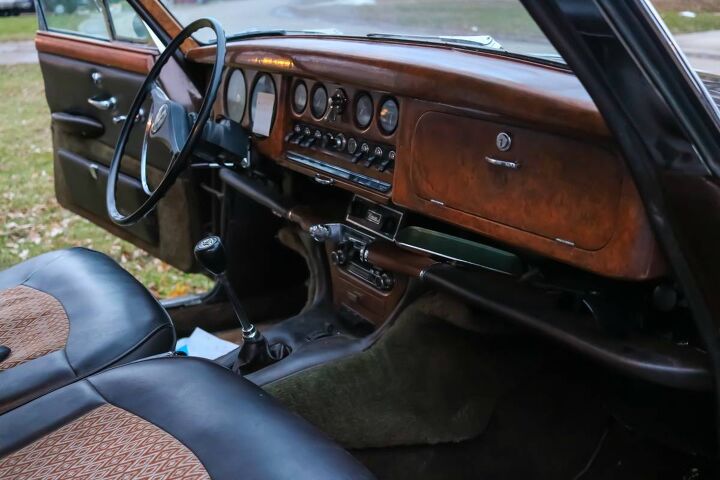Rare Rides: The Sports-Luxury 1966 Jaguar S-Type 3.8

Long before the Ford-based retro throwback began showing up on dealer lots, Jaguar produced a contemporary and modern sedan called the S-type. Let’s check out a brown example, this one hailing from 1966.
Much like the 2000s S-Type, the original was intended as a more affordable luxury alternative to Jaguar’s flagship sedan offering. At the time, the S-Type was the alternative to the large Mark X. Jaguar founder Sir William Lyons realized, after looking at the company’s new and technologically advanced Mark X and E-Type models, that the Mark 2 was in need of a revision. Engineers set to work.
The well-known styling of the Mark 2 saw some rework, resulting in a more modern look. Jaguar elongated the rear of the sweeping sedan for a smoother appearance, with the interior trim seeing its own update. Critically, the live rear axle suspension was replaced with an independent setup. The longer flanks and additional luxury equipment meant a weight gain of 335 pounds over the Mark 2, but Jaguar’s engineers (or accountants) did not feel that any changes to the braking system were necessary. The panned steering of the Mark 2 was replaced with a tighter power steering system promising more driving feel.
S-Types engines were hand-me-downs from other Jaguar vehicles. The S-Type was first introduced with the 3.8-liter engine from the Mark 2, with a lower-end 3.4-liter engine available a bit later. Jaguar was careful with its engine presentation. No 3.4-liter models were sold in the United States, and said engine was omitted from press demonstration cars in the United Kingdom. The 3.8 was the more popular engine choice by a 3 to 2 ratio in the S-Type, even though the 3.4-liter was more popular in the Mark 2. Even though both engines could be had with triple carburetors by that time, the S-Type’s engines only had two. The triple setup would not fit into the dated Mark 2 engine bay of the S-Type. Transmission options included a four-speed manual, four-speed with overdrive, or a three-speed automatic.
Mark 2 revisions complete, the S-Type hit dealer lots in 1963. The brand’s product lineup at the time included the E-Type coupe, as well as the Mark X, Mark 2, and 420 sedans, in addition to the new S-Type. While the Mark X did not grab buyers as well as hoped, the Mark 2 ended up selling better than expected, even at its advanced age. Lyons decided to maximize sales possibilities and sell all four at the same time. Things stayed this way through 1967, with the Mark X renamed as 420G.
The new XJ6 came along in 1968, replacing all of Jaguar’s sedan offerings (with the exception of the 420G).
Today’s Rare Ride is located in central Illinois, and, with 78,000 miles on the clock and excellent patterned fabric seats, asks $6,000.
[Images: seller]

Interested in lots of cars and their various historical contexts. Started writing articles for TTAC in late 2016, when my first posts were QOTDs. From there I started a few new series like Rare Rides, Buy/Drive/Burn, Abandoned History, and most recently Rare Rides Icons. Operating from a home base in Cincinnati, Ohio, a relative auto journalist dead zone. Many of my articles are prompted by something I'll see on social media that sparks my interest and causes me to research. Finding articles and information from the early days of the internet and beyond that covers the little details lost to time: trim packages, color and wheel choices, interior fabrics. Beyond those, I'm fascinated by automotive industry experiments, both failures and successes. Lately I've taken an interest in AI, and generating "what if" type images for car models long dead. Reincarnating a modern Toyota Paseo, Lincoln Mark IX, or Isuzu Trooper through a text prompt is fun. Fun to post them on Twitter too, and watch people overreact. To that end, the social media I use most is Twitter, @CoreyLewis86. I also contribute pieces for Forbes Wheels and Forbes Home.
More by Corey Lewis
Latest Car Reviews
Read moreLatest Product Reviews
Read moreRecent Comments
- Wjtinfwb 100k. What happened to the 40k version I reserved back a year + ago? Regardless, since you could by a new Silverado Trail Boss V8 for 60k and put the remaining 40k in a Money Market at 4-5%, why would anyone spend the extra $$$? And please don't make it about the environment. Moving a 3 ton truck through the air is going to take a lot of energy and energy doesn't fall out of trees. Whether Solar, Wind, Nuclear or Mermaid farts, there's a financial and environmental impact. Why not go with the least expensive impact?
- Wjtinfwb Oh boy. These "over the air" updates really concern me as well, so much that I've disabled the feature on my '23 Bronco. No issues yet but if a software company the caliber of Apple is challenged by these updates, my confidence in Ford (or GM, Stellantis, BMW, etc.) ability to execute them flawlessly is more than suspect.
- Dartman “That’s right Kwik; if you’re not paying for it you are the product-even on TTAC. May I help you with anything else? If we’re done here I need to call Siri- goodbye!”
- Jalop1991 “We left nothing to chance during development and tested the new 911 under all sorts of conditions all over the world."Except for idiot end users. Trust me, the first one on the streets will break quickly and hard in ways the engineers will struggle to understand.
- Kwik_Shift_Pro4X Information is power and makes money for those who sell it. Right Alexa? 🤪






































Comments
Join the conversation
It's nice to see what quality leather and wood actually looks like. It's been a while.
Nice although I too prefer the MKII . -Nate